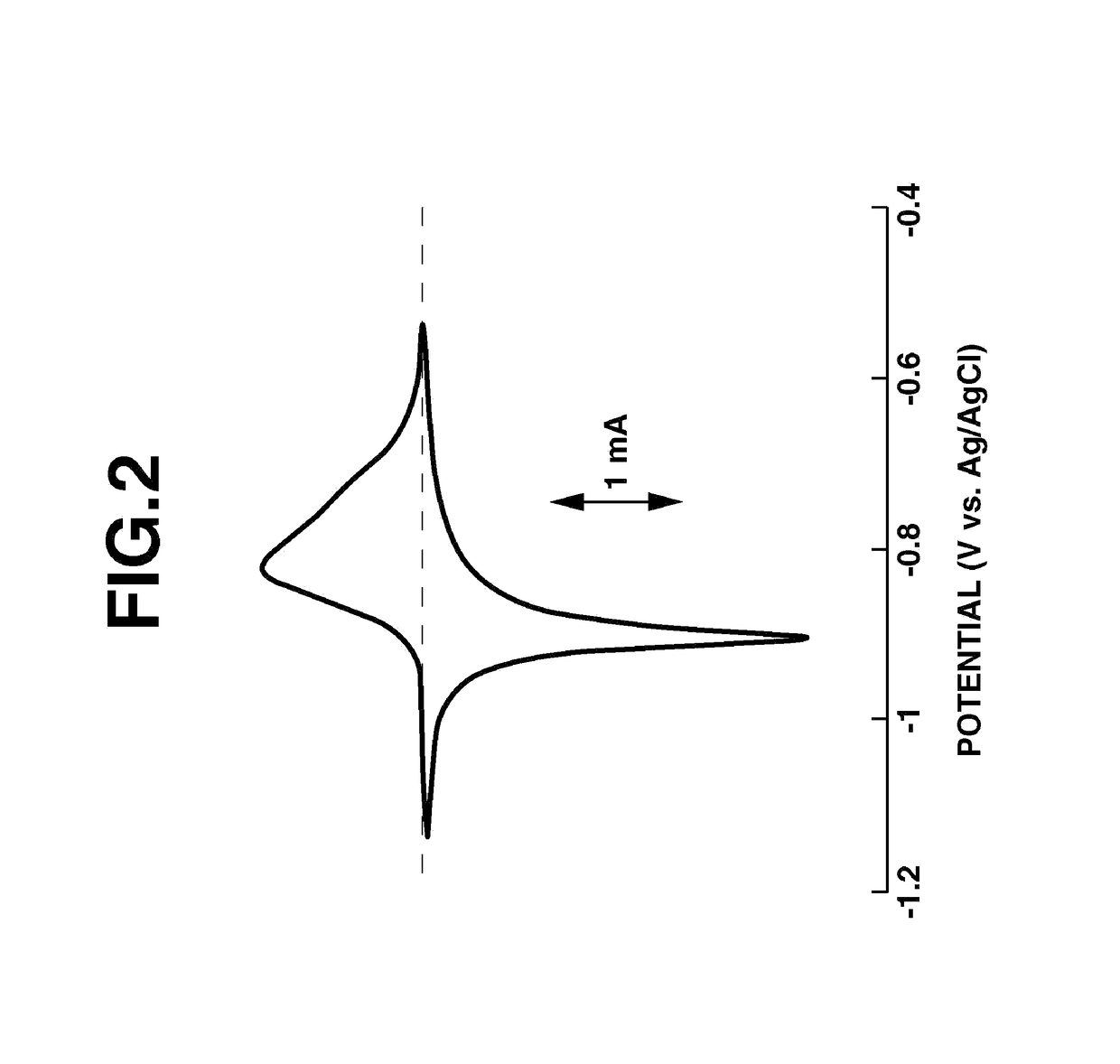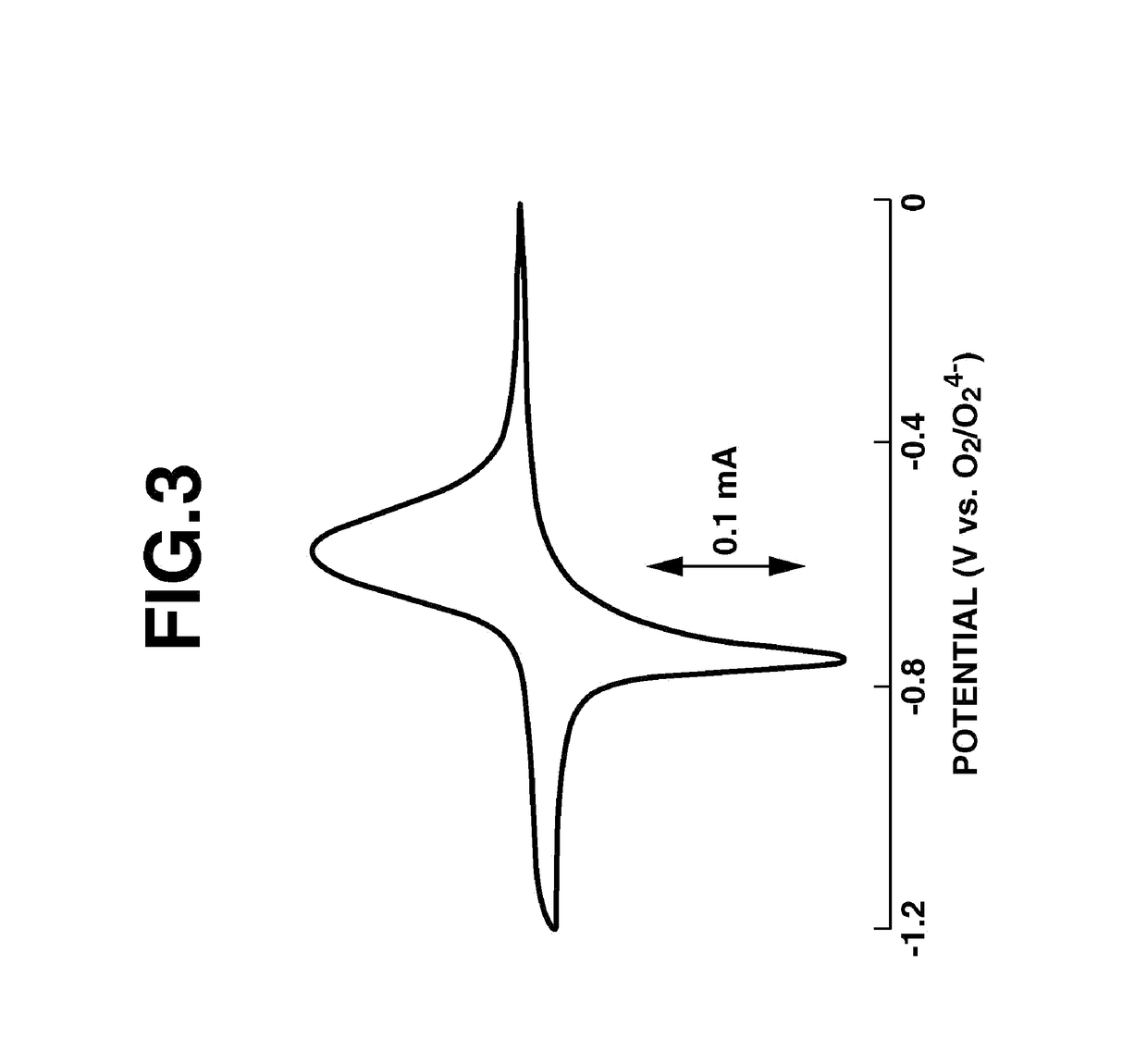Fused-ring quinone-substituted polynorbornene, electrode active material and secondary battery
a polynorbornene and active material technology, applied in the direction of fuel, primary cells, cell components, etc., can solve the problems of inability to obtain sufficient cycle characteristics, low electrochemical stability, and sometimes unattainable satisfactory performance as a secondary battery, especially a lithium ion battery, and achieve high capacity, high stability, and high electrochemical stability
- Summary
- Abstract
- Description
- Claims
- Application Information
AI Technical Summary
Benefits of technology
Problems solved by technology
Method used
Image
Examples
example 1
of Polymer A
Example 1-1: Synthesis of 2-Iodoanthraquinone
[0129]
[0130]2-Aminoanthraquinone (5 g, 22.3 mmol) was added to a 100 mL beaker and dissolved in 20 g (204 mmol) of sulfuric acid. Next, 5 g (72.5 mmol) of sodium sulfite was slowly added and the reaction was carried out at 0° C. for 2 hours. Following the reaction, 1 L of ice water was prepared in a 2 L beaker, and the reaction mixture was poured therein. After 1 hour of stirring, the precipitated solids were removed by filtration and 2.5 g (15.1 mmol) of potassium iodide was added to the filtrate, which was then left at rest for 3 hours. The precipitate was recovered, following which 2.5 g (15.1 mmol) of potassium iodide was added to the filtrate, which was then left at rest for 3 hours. This operation was repeated three or four times. The recovered solids were liquid-liquid separated using chloroform / aqueous sodium thiosulfate solution, and the iodine was removed. Following liquid-liquid separation, column purification with ...
example 1-2
f 2-Pinacolboronanthraquinone
[0136]
[0137]2-Bromoanthraquinone (1 g, 3.48 mmol), bis(pinacolato)diboron (973 mg, 3.83 mmol) and potassium acetate (1.02 g, 10.4 mmol) were added to a 30 mL round-bottomed flask, and dissolved in 20 mL of DMSO under an inert atmosphere. Next, 570 mg (0.7 mmol) of PdCl2(dppf) dissolved in 3.2 mL of DMSO was added with a syringe and the reaction was carried out at 80° C. for 24 hours. Following reaction completion, the solvent was removed, and liquid-liquid separation with chloroform / saline and column purification with chloroform yielded 2-pinacolboronanthraquinone as a yellow powder. The 1H-NMR and FAB-MS results are given below.
[0138]1H-NMR (CDCl3, 500 MHz, ppm):[0139]8.74 (s, 1H, Ph), 8.27 (m, 4H, Ph),[0140]7.88 (m, 2H, Ph), 1.38 (s, 16H, CH3)
[0141]FAB-MS (m / z): Calculated, 334.17. Found, 335.19.
example 1-3
[0142]
[0143]2-Iodoanthraquinone (1 g, 3 mmol), 1.1 g (3.3 mmol) of 2-pinacolboronanthraquinone, and 1.1 g (7.92 mmol) of potassium carbonate were added to a 20 mL round-bottomed flask, after which these were dissolved by adding 10 mL of a THF / water (1 / 1) mixed solvent with a syringe under an inert atmosphere. Following dissolution, 1.2 mL of 2,5-norbornadiene was added and the system was heated to 60° C. Next, 27 mg (0.12 mmol) of Pd(OAc)2 and 75.4 mg (0.29 mmol) of PPh3 were dissolved in 2 mL of THF and subsequently added and the reaction was carried out at 60° C. for 24 hours. Following reaction completion, the solvent was removed and liquid-liquid separation using chloroform / saline and column purification with chloroform were carried out, yielding Compound A as a yellow solid. The 1H-NMR and FAB-MS results are given below.
[0144]1H-NMR (CDCl3, 500 MHz, ppm):[0145]8.18 (m, 4H, Ph), 7.95 (d, 2H, Ph),[0146]7.88 (d, 2H, Ph), 7.71 (m, 4H, Ph),[0147]7.32 (dd, 2H, Ph), 6.53 (...
PUM
| Property | Measurement | Unit |
|---|---|---|
| temperature | aaaaa | aaaaa |
| temperature | aaaaa | aaaaa |
| thickness | aaaaa | aaaaa |
Abstract
Description
Claims
Application Information
 Login to View More
Login to View More - R&D
- Intellectual Property
- Life Sciences
- Materials
- Tech Scout
- Unparalleled Data Quality
- Higher Quality Content
- 60% Fewer Hallucinations
Browse by: Latest US Patents, China's latest patents, Technical Efficacy Thesaurus, Application Domain, Technology Topic, Popular Technical Reports.
© 2025 PatSnap. All rights reserved.Legal|Privacy policy|Modern Slavery Act Transparency Statement|Sitemap|About US| Contact US: help@patsnap.com



